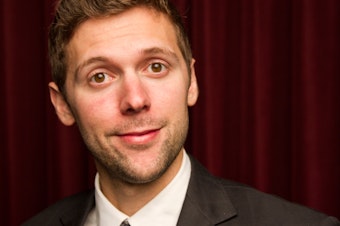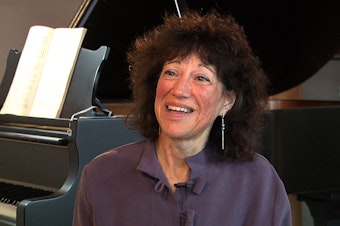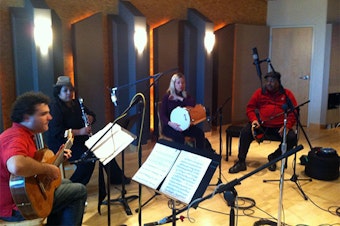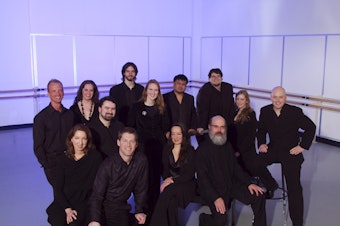Dave Beck
Stories
-

Forest Gibson: "Going Far Beyond Your Normal Reach"
Forest Gibson is a Seattle-based video producer and filmmaker. Forest and the company that he works for, Cinesaurus, have a knack for producing videos that get shared on the web and social media. Cinesaurus' clients include GAP, YouTube and the online humor network Cheezburger. One of the company’s biggest successes was the parody video released in the summer of 2012, “We’re NASA and We Know It.”http://youtu.be/QFvNhsWMU0cForest Gibson, director of “We’re NASA and We Know It,” was one of those kids who was really into exploring space. He watched all the "Star Wars" movies, followed the adventures of Captain Picard and the Starship Enterprise, and admired the stories of that motley crew of space explorers on the sci-fi series "Firefly." Just like their TV and movie heroes, Forest and his lawyer father aimed for the stars.Lots of homemade missions began on the Gibson’s neighborhood launch pad in Yakima, Washington. Forest loved watching the rockets he made fly up into the skies. He describes it as “this kind of awe of making something going far beyond your normal reach.”But when Forest’s middle-school-math skills weren’t up to NASA standards, he put his astronaut dreams aside and became a filmmaker instead.Along with launching rockets, Forest also loved to take pictures of his toys and make stop-action videos out of the images. He was the "video guy" in high school, always recruiting friends to make short movies. In college he organized festivals featuring short films.Last summer, when the NASA Curiosity rover landed on Mars Forest rounded up a group of friends and made the parody music video “We’re NASA and We Know It.” Forest and his team put the video together in the week following the Curiosity landing. They made costumes, built sets and shot the video around Seattle’s Westlake Center. The parody video features normally serious NASA scientists and flight controllers singing, dancing and "geeking out" over technical details of the rover mission and NASA traditions.The video was hugely popular the moment it was released. It’s been viewed by over 2.5 million people on YouTube. The video found its way onto the "Today" show and National Public Radio. NASA even tweeted the video to more than 2 million followers. Forest was ecstatic.And things got even better when he received an email from NASA telling him astronauts were listening to “We’re NASA and We Know It” while prepping for their spacewalks.Forest could hardly believe what he was hearing. He might not have made it to space, but his video did. And his relationship with NASA, and with space exploration, doesn’t end with the video.Forest is now receiving invitations to work with NASA and companies like Planetary Resources, a Seattle-based asteroid mining company. Forest says they want to work with him “in storytelling and making videos and marketing and doing social media — all of these things that are in my background and aren’t traditionally connected with space in any way. It was just mind blowing! It opened my eyes to the possibility I really could be accomplishing my dream.”This story originally aired on December 17, 2012.
-

Commemorating The Holocaust In Music
Mina Miller is a Seattle pianist who founded the organization Music of Remembrance 15 years ago. Her passion for the organization springs in part from her family history. Mina comes from a Holocaust family.My parents were the only survivors in their entire families. They managed to emigrate to America just in time. They came in 1939, around the time of the World’s Fair. They came from Lithuania. But their entire families were murdered. To this day I still have a problem identifying when people talk about their relatives — when they talk about this aunt, this uncle, this cousin. I am like a 3-year-old having to figure this out. I didn’t know any family except that they were all dead. They were all murdered.The organization that Mina founded in 1998 commemorates the Holocaust by producing live performances and recordings of works by artists like composer Viktor Ullman. He wrote his 1943 opera “The Emperor of Atlantis” while imprisoned in the Terezin Concentration Camp. Ullman’s darkly satirical opera is aimed directly at Hitler and the Nazi dictator’s mistress Eva Braun.The opera was originally intended to be performed at Terezin, a camp in which Nazi captors, for propaganda purposes, encouraged the creativity of the incarcerated artists and musicians. But the subject matter of Ullman’s opera proved too subversive for the time and circumstances.Shortly after he completed “The Emperor of Atlantis,” Ullman was transported to Auschwitz and executed in the gas chambers. His opera wasn't performed until 1975.Mina Miller says her work with Music of Remembrance is always driven by inspiration drawn from stories of artists and the Holocaust:As a musician I always felt that music should serve a higher purpose, not just serve as entertainment. It should convey a message. It should communicate something that gets at the essence of who we are. When I researched the Holocaust and I came to know the kind of performances that were taking place in Terezin, I understood that there was a profound human spirit there. These artists, knowing that they were going to die, created music up to the very last moment! I felt with Music of Remembrance there could be a vehicle to present this music. And we build new bridges and bring music to new generations by commissioning new music that reflects on the Holocaust and tells new stories that need to be heard.Seattle Symphony conductor Ludovic Morlot and 13 members of the orchestra will accompany the singers in performances of “The Emperor of Atlantis” this weekend in Benaroya Hall. These concerts, marking the beginning of the 15th season of Music of Remembrance are Friday, November 16 at 8:00 p.m. and Sunday, November 18 at 6:00 p.m.
-

The Brazilian Sounds Of Choro: A Living Tradition
Stuart Zobel is the guitarist in the Seattle-based band Choroloco. The band plays music from Brazil called “choro.” Stewart says the infectious rhythms and melodies of the music, and the spirit of community associated with the choro style is what draws him to the music. He says:All segments of Brazilian society were involved with it. You had a lot of the upper classes with their pianos, playing music from Europe and fusing it with other styles. And they were actually getting together with other people outside of their class or race and playing. It reminds me a lot of old timey music and jam sessions and circles here in the United States. That happens in Rio with choro and they call these gatherings the "rodas de choro" and that means wheel or circle of choro. Anybody can show up. Any instrument can come.Rosalynn De Roos is the clarinetist and band lead in Choroloco. She put the group together about five years ago when she was studying Latin music styles at Seattle’s Cornish College of the Arts. Rosalynn says choro has its roots in the music of African slaves who were brought to Brazil. There are also elements of European chamber music and indigenous sounds from Brazil’s native population. She and other musicians love the style because there’s something in it from so many traditions, styles and approaches to music making. She says:I’m constantly listening to this music, reading about it, studying up on the composers — and it is a living tradition. As a North American I’m taking this music, re-interpreting it and putting my own spin and voice on it. And so there is a marriage of the old and new. I keep it fresh and different, but also try to protect the tradition out of respect and joy and love for it.Members of Choroloco visited us in the performance studio at KUOW this week and played two pieces from the choro tradition. KUOW sound engineer Eamon Nordquist recorded the session. Choroloco and other Brazilian bands and artists who make their home in the Pacific Northwest will play together on Friday, November 9 at 8:30 p.m. in the Royal Room in Seattle’s Columbia City neighborhood.
-

Seattle's Tudor Choir: Twenty Years Of Vocal Excellence
Seattle’s Tudor Choir is a 20 year-old institution founded by a University of Washington student with a passion for music and history. During his years at the University of Washington, Tudor Choir founder and artistic director Doug Fullington put together a group of fellow students to sing English Renaissance music associated with the Tudor Monarchy of the 15th and 16th centuries.Doug also found an outlet for performing English choral music as a member of the Compline Choir at Seattle’s St. Mark’s Cathedral. In 1993 Doug called on his fellow choral enthusiasts from St. Mark's and the UW and created a professional ensemble. He christened it the Tudor Choir. This season the choir celebrates its 20th season of acclaimed performances and recordings.Doug Fullington says the reflective mood, rich harmonies and soaring melodies of English choral music – often written for the church – have an appeal that transcends religious and cultural boundaries. Doug says, "There’s a great profundity to this music, even if you’re not completely aware of what the text might be, or even if it doesn’t suit the beliefs that you’ve chosen. The music creates a wonderfully contemplative and expressive atmosphere that speaks to so many people."Over the years the Tudor Choir has expanded its repertory from early English music to choral sounds associated with colonial America. Shape-note singing is a raucous style of community singing associated with congregations in New England and the Southern United States in the late 18th and early 19th centuries. Doug Fullington and the Tudor Choir gradually added this music to their repertory over the course of the Tudor Choir's 20-year history. The choir recorded shape-note music and sang it on a 1995 national radio broadcast of A Prairie Home Companion. Doug says the independent vocal lines of shape-note singing provide good training for his singers. The challenges of American shape-note singing can be applied in tackling the complexities of Renaissance music."The shape-note music is characterized by a great independence of the four vocal parts. Each part competes to out sing the other parts. That was the style. And for us as a choir it was wonderfully instrumental in helping us develop a lot of vocal independence as individual singers. It in turn really influenced how we approached the Renaissance music."Doug Fullington is a Renaissance man with a keen ear for Renaissance music. When he put together the Tudor Choir in 1993 he was working on his law degree from the University of Washington. But law never became Doug’s profession. Outside of UW Law School, Doug’s passions included not only historical English choral music, but the history of Russian classical ballet as well. Along with his work as artistic director of the Tudor Choir, Doug went on to a career as a professional dance historian and arts administrator for Pacific Northwest Ballet in Seattle.The Tudor Choir celebrates its 20th anniversary with a series of concerts this season at Seattle’s Blessed Sacrament Church in the University District.Watch a YouTube performance of "Spem In Alium" by Thomas Tallis with the Taverner Choirhttp://youtu.be/7Cn7ZW8ts3Y
-
Northwest Travel Writer Recommends Visiting Mount St. Helens This Fall
Seattle travel writer Crai Bower first came across Mount St. Helens when he was doing a census of the spotted owl population for the Washington State Department of Natural Resources in 1990. Crai was stunned by the vision of Mount St. Helens, which so famously and destructively erupted in 1980. Crai remembers seeing the mountain as he walked down a forest service road: